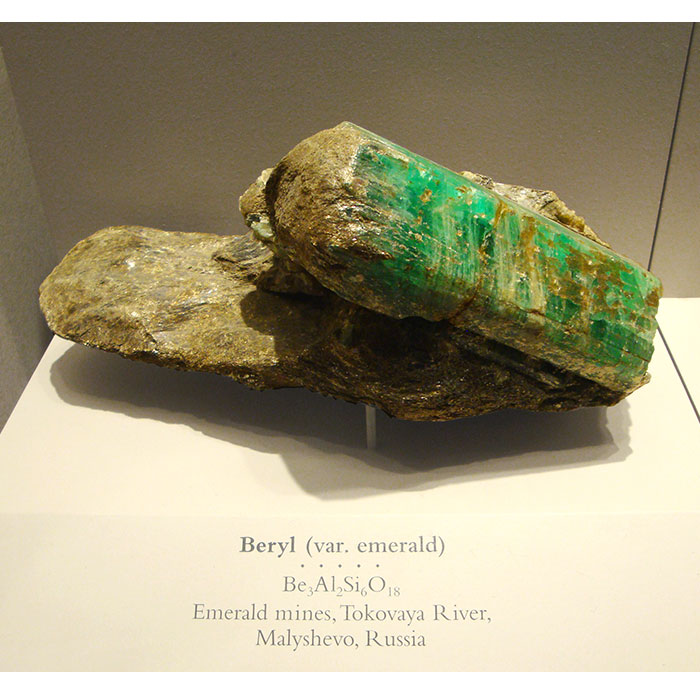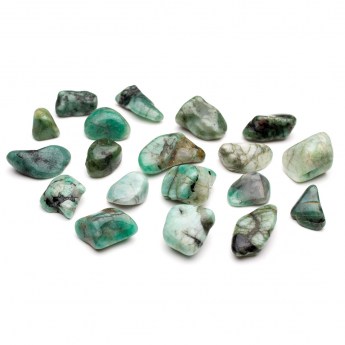Emerald (Gemstone): Facts and Photos

| Contents 1. What is Emerald? 2. Grading Emerald Gemstones 3. Article Pictures 4. Shop Emerald |
What is Emerald?
Emerald is a green variety of the mineral beryl whose magnificent colour is caused by trace amounts of chromium, vanadium and beryllium.
Flawless emeralds are incredibly rare. The vast majority are small, heavily included and feature surface-reaching fissures and fractures. These often cause stones to break very easily. For this reason, emeralds are often treated to fill cracks and improve clarity.
Numerous treatments have been devised over the years to hide or disguise flaws. The finest-grade emeralds command staggering prices.
Although lower-grade emeralds are abundant worldwide, fine-grade stones are extremely rare.
The history of the emerald can be traced back to ancient Egypt, where it was mined as early as 1500 BC.
The name comes from the Latin word 'esmaralda' (feminine) or 'esmaraldus' (masculine), a variant of the Latin word 'smaragdus', which originated in ancient Greece. 'Smaragdos' means 'green gem.'
Cleopatra loved emeralds and often covered herself in them on official occasions. Her palaces are believed to have been lavishly decorated with them.
Having stated the stones were only fitting for Egyptian royalty, the emerald mines were made her personal possession. Cleopatra's portrait was often engraved onto larger stones which were then gifted to her favourite ambassadors.

Columbia mines more emeralds than any other country. The finest stones come from mines around Muzo, known as the emerald capital of the world. The next largest producer is Zambia.
In October 2018, a 5,655-carat stone was found at Kagem, the world's largest emerald mine.
The 'Gachalá Emerald' is one of the world's largest and most famous emeralds. It weighs 858 carats and was found in the Muzo mines in 1967. It's named after the town of Gachalá, where it was discovered.
Another famous stone is the Duke of Devonshire Emerald, which was also discovered in Muzo. It weighs 1,383.93 carats.
The Gachalá Emerald is housed in the Smithsonian Institute in the U.S., and the Duke of Devonshire Emerald is in the Natural History Museum London.
Being lighter than diamond and sapphire means an emerald of the equivalent weight would be considerably larger.
On the Mohs scale of mineral hardness, emerald grades 7.5 to 8. Although very hard, it's also very brittle.
A mineral's hardness is often confused for toughness but the two characteristics are not the same.
Emerald is the modern birthstone for May.

Grading of Emerald Gemstones
Several characteristics are taken into account when grading coloured gemstones. Colour is generally the most important, but with that said, in emeralds, clarity comes a close second. Richness of colour, saturation and tone are also important.
Despite being the green variety of the mineral beryl, not all green beryl is emerald. Before a stone can be classified as emerald, it must undergo rigorous testing. During this process, the cut, shade, depth of colour, clarity and carat weight are assessed.
When assessing a diamond's clarity, a loupe is used for closer inspection. This small, powerful magnifier is held close to the eye. However, inspection of an emerald is often done without any magnification. If no visible inclusions can be seen, it's classified as flawless.
Article Pictures
The photos in our article are clickable and redirect to the original image. The piece at the top of the page is housed in the Smithsonian Museum of Natural History, Washington D.C. Photo by Stone Mania.
The emeralds in the second two pictures are in the Natural History Museum of Los Angeles. Photos courtesy of Stan Celestian.
Pop-up photos: Emerald - Courtesy of Stan Celestian.











